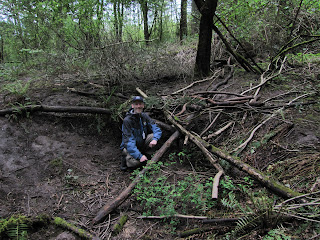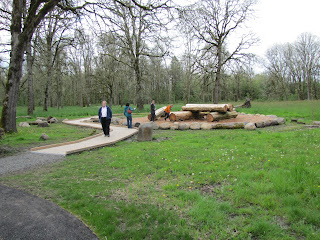The Tualatin Hills Parks and Recreation District (THPRD) in Oregon has put together some interresting nature play guidelines. I have not seen many parks districts or departments attempt to put together a set of guidelines for nature play. This might be the first document of its kind! I think this document includes many of the basic concepts and approaches taken in public playgrounds in the US. It is worth the read and is a great place for parks providers to start when creating their own guidelines.
THPRD breaks the concept of nature play into two catergories as follows:
Off-trail play areas
Will involve opening designated sections of existing natural area parks for
unstructured free-play, where kids can discover and participate with nature on their own terms. These areas should have characteristics that will allow for an interactive experience with native habitat, including a diversity of plant size and species, fair level of ecological health, and variation in terrain. The needs of successful play areas should be balanced with natural resources concerns and general habitat health. |
| Bruce Barbarasch of THPRD ducks into one of the forts in an off-trail play area. Bruce has been the leading force behind the creation of the Hyland Park off-trail play area. |
Natural playscapes
Involve the design of nature-inspired play areas, incorporating natural elements (plants, water, topography, logs, boulders, etc.) and built play structures to provide for a sensory experience of nature and a variety of types of play activities. As a hybrid of nature and traditional play areas, these playscapes will adhere as much as possible to existing applicable safety guidelines.
 |
| Camille Park Nature Play Climbing Logs |
THPRD's Nature Play Goals
- Provide children of all ages, abilities, and socio-economic backgrounds with safe, accessible spaces in which they can interact freely with the natural world.
- Allow these spaces to be as inherently natural a setting as possible, and, when existing spaces aren’t available, to design and maintain spaces with nature as the guiding inspiration.
- Appreciate the potential for play inherent within children, and to provide a setting that encourages the use of creativity and imagination rather than, or in addition to, one which allows only for prescriptive physical activities.
- Recognize the value of these spaces as means for environmental education on various levels, including spontaneous and formal adult teaching, as well as that provided by hands-on, unstructured play.
- Make areas attractive as community features.
Do you know if any other nature play guidelines that I have not seen? Please let me know.

No comments:
Post a Comment